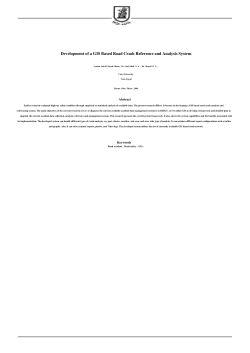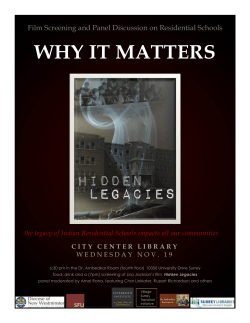
On May 7, 2015 Stanford Libraries` Center for Interdisciplinary
On May 7, 2015 Stanford Libraries’ Center for Interdisciplinary Digital Research (CIDR) hosted a 4 hour panel discussion on the topic of GeospaGal NarraGve. The panel coincided with a visit by UC Berkeley geographer David O’Sullivan, who gave a guest lecture later in the day, “Simple spaGal models: Building blocks for process-‐based GIS?” 1 Only one non-‐geographer (most welcome of course) in the panel 2 Prior to the event a list of quesGons to be considered was developed by the panelists 3 The Center for Interdisciplinary Digital Research (CIDR) is a new organizaGon within Stanford Libraries, which has brought together several exisGng groups supporGng faculty-‐led research in the HumaniGes and Social Sciences 4 A few definiGons from OED and elsewhere. There are several disGnct senses of the term “narraGve.” 5 The se_ng for the panel was CESTA, which includes Stanford’s SpaGal History Project. Faculty, postdocs, and student researchers have produced dozens of geospaGal narraGves there over the last decade. 6 One important enabler of the work at SpaGal History has been the Flash/Flex technical pladorm developed by Erik Steiner and refined over the years. While the rest of the world was waiGng for web-‐based mapping to catch up, SpaGal History folks were building great geospaGal narraGve applicaGons. Now that web mapping has caught up, the technical pladorms choices have expanded dramaGcally, and this form of scholarly producGon is available to many more people. 7 The applicaGon pafern for telling stories with maps has several prominent examples. Each has allows joining maps, Gmelines, text and imagery in interacGve displays. 8 The pafern of “space, Gme, and theme” as the principle dimensions of geographic informaGon was theorized and modeled by Berry 50 years ago. 9 And Berry’s matrix is reflected in all modern mapping narraGve pladorms listed earlier. 10 One of my current interests, and a moGvaGon for organizing the panel, is a desire to see further interacGon between humaniGes scholars exploring spaGal (i.e. geographic) perspecGves on their quesGons and pracGGoners of Geographic InformaGon Science (GIScience), of which I am one. In fact there has been a steady, if narrow, stream of qualitaGve and quanGtaGve narraGve work by geographers in the last couple of decades, for example by Mei-‐Po Kwan 11 Our guest is in his own words, “si_ng at the boundary between quanGtaGve and qualitaGve methods.” He is renowned for spaGal analysis and simulaGon, as well as CriGcal GIS. 12 There is a discussion between humaniGes scholars and GIScienGsts, as in this day-‐ long meeGng several years ago, but it is minimal halGng. 13 Some topics of interest to humanists, e.g. Place, have been of interest in GIScience… not hugely, but a steady stream. The concept of Place and “placial” is gaining tracGon in fact. 14 A few GIScience types – like May Yuan can be found (ir)regularly at DH and historical GIS venues 15 The Alliance of Digital HumaniGes OrganizaGons (ADHO) recently encouraged formaGon of Special Interest Groups, and I co-‐found GeoHumaniGes SIG with Kathy Weimer, a map and geospaGal data librarian, now at Rice University. The AssociaGon of Amrican Geographers (AAG) recently launched a new journal Gtled GeoHumani*es, and the 2015 conference had GeoHumaniGes as a featured track, with 40+ relevant paper sessions 16 17 Back to the quesGons. Some of what was discussed will be found in the blog post these slides are situated in. 18
© Copyright 2025





















